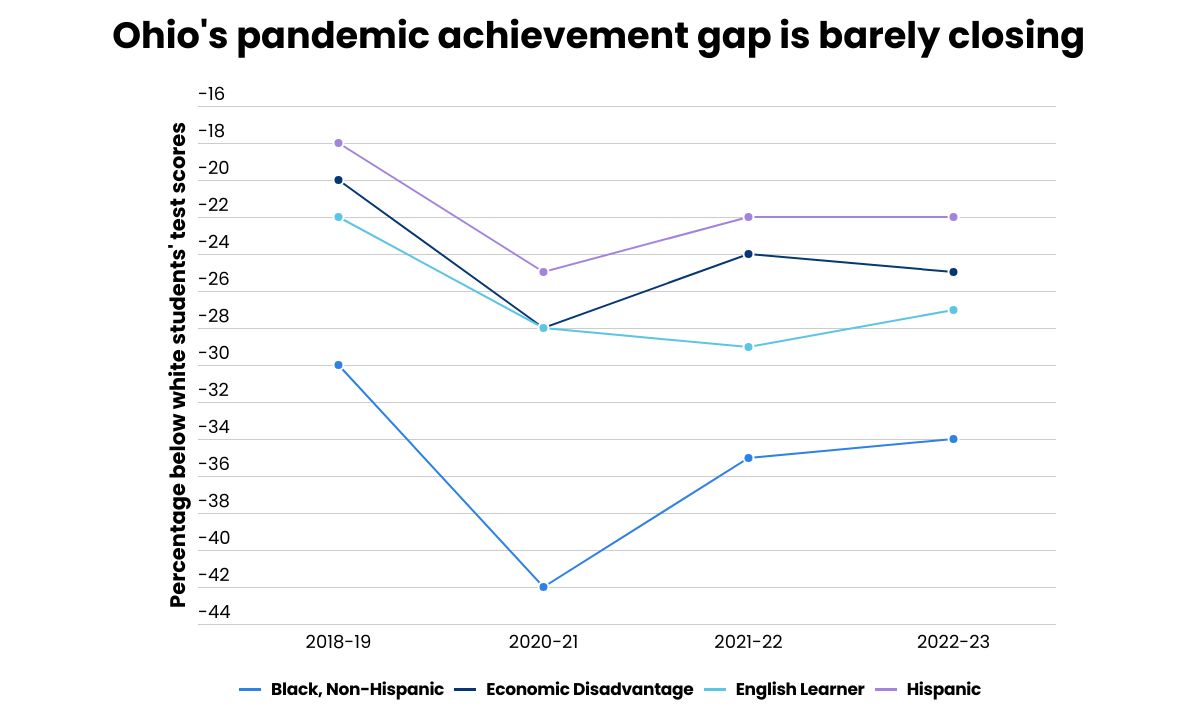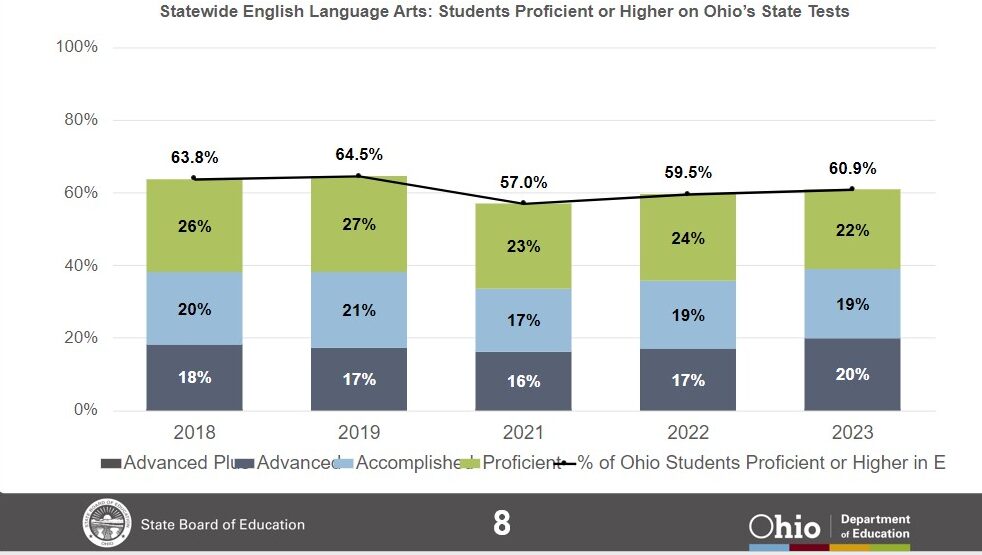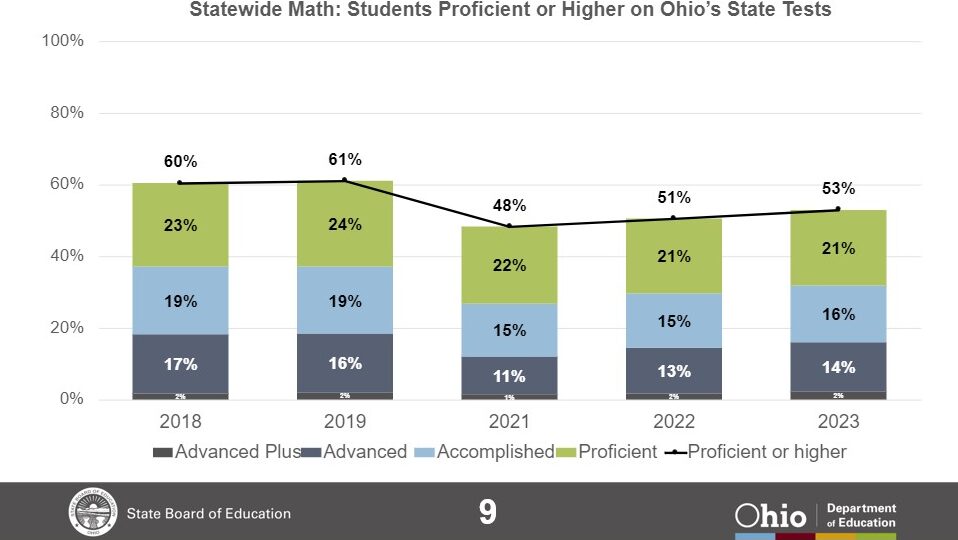Ohio’s Pandemic Recovery Slows As Achievement Gaps Fail To Close
Students gained less on 2023 tests than 2022, while challenged groups remain further behind their peers than pre-pandemic.

Get stories like this delivered straight to your inbox. Sign up for The 74 Newsletter
After raising hopes last spring the pandemic-fueled academic gap was closing, progress for Ohio’s most vulnerable students has stalled, new test results show.
Black, Hispanic, poor and special needs students, all hit hard by the pandemic, made significant progress on spring 2022 state tests, placing them closer to their white, affluent peers — at least to pre-pandemic levels when there were already long standing achievement gaps.
But test results from spring 2023 show the state’s most vulnerable students have barely moved the needle on the exams and are now crawling in efforts to make up ground compared to their more advantaged peers.
Black students in spring 2022 scored 35% lower on the math, reading and limited science and social studies tests than white students — a huge gain from being 42% behind their white students in 2021.
But in spring, 2023, the upward trend for Black students slowed, shaving just one point to 34% lower than white students.
Low income students also shaved just a single point off the gap in 2023 after cutting it by four points the year before.
Ohio State University Professor Vladimir Kogan, who analyzed student scores this summer, worried students might not ever catch up if progress stays this slow.
“They started the race a mile behind, so if they want to get to the finish line at the same time, not only do you have to keep pace, but they have to run faster,” Kogan said “They may be catching up as quickly as everybody else, but because they started off so far behind, that’s not going to be good enough to get to a level playing field.”
Ohio’s new state report cards showed several other trends in students’ recovery from the pandemic:
- Giant 2022 score gains from the pandemic lows of 2021 seem to be a one-time boost. Though students across Ohio improved in 2023, they gained a quarter of what they did the year before. A state composite of all tests and grades showed just a 1.6 point gain in 2023 compared to a 6.8 point gain in 2022
- Mirroring a national trend, Ohio students remain twice as far behind in math as they are in English.
- Students in middle school and high school are running out of school years to make up lost ground, particularly in math.
Kogan estimated the older students are close to a half an academic year behind pre-pandemic levels. “Obviously, there’s not a lot of time left for those students,” he said.
Interim state Superintendent Chris Woolard said the overall results are encouraging, though not without worries.
“We’re seeing improvement, that’s a good thing,” Woollard told the state board Monday. “But we have a lot of work to do particularly with our most vulnerable students.”
Ohio is one of the earliest states to release 2023 test data to add to the national debate over pandemic recovery. The 2022-23 school year also offered the closest thing to a typical school year post-pandemic.
Ohio’s overall results fit a developing national pattern. English and reading scores are still down statewide, though math declines are twice as large. The National Assessment of Educational Progress (NAEP) — known as the Nation’s Report Card — showed math scores dropping nine points, compared to four in Reading. Texas also showed larger math drops than in English this year.
In Ohio, the statewide reading proficiency rate of 60.9% remains down about 3.7 percentage points from 64.5% pre-pandemic. Kogan’s analysis showed students scoring closer to pre-pandemic levels than urban ones.

The state has a clear plan to boost reading scores. Gov. Mike DeWine received strong backing from the state legislature this year mandating schools start using “science of reading” approaches in teaching young students.
Ohio’s math proficiency rate, however, is still down eight percentage points — twice as much as the reading decline — from 61% pre-pandemic to 53%. As with reading, the state made only slight progress in closing that gap this last school year compared to 2021-22.

Leaders of the Ohio Council of Teachers of Mathematics noted that math relies on students learning concepts well and then building on them later, which school closures and online classes hindered.
“It is more difficult for students who didn’t have opportunities to build those concepts well because of the loss of instructional time,” said OCTM President Gabriel Matney.
Ohio’s math recovery plan is more limited than in English, relying on tutoring and the state paying for the math learning program Zearn to be available to all teachers.
Get stories like these delivered straight to your inbox. Sign up for The 74 Newsletter

;)
